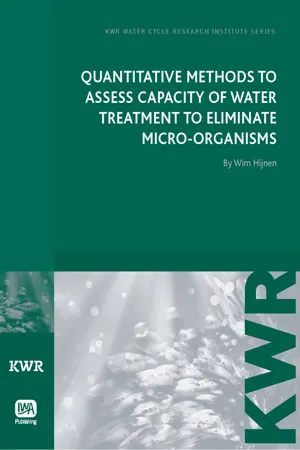
Quantitative Methods to Assess Capacity of Water Treatment to Eliminate Micro-Organisms
- 290 pages
- English
- PDF
- Available on iOS & Android
Quantitative Methods to Assess Capacity of Water Treatment to Eliminate Micro-Organisms
About This Book
Special Offer: KWR Drinking Water Treatment Set - Buy all five books together and save a total £119!
Ever since the recognition of the important role of water in the transmission of pathogenic micro-organisms in the 19th century, microbiological safety of drinking water has been a major research issue for microbiologists in the drinking water industry. The main objective of this book is to develop a general strategy to assess elimination capacity of water treatment processes for pathogens.
It investigates: The potential use of faecal indicators Coli44, (including E. coli ) and SSRC, (including C. perfringens ) as process indicators to assess pathogen elimination in full-scale water treatment plants. The value of comparative challenge tests with pre-cultured organisms for the assessment of elimination capacity of full-scale processes, to study the effect of process conditions and to validate the use of process indicators. The use of literature data to assess elimination capacity of water treatment processes for pathogens and the effect of process conditions on this.
Visit the IWA WaterWiki to read and share material related to this title: http://www.iwawaterwiki.org/xwiki/bin/view/Articles/WaterbornePathogens
Frequently asked questions
Information
Table of contents
- Half Title
- Title
- Copyright
- Contents
- Preface
- Summary
- Chapter 1: Microbiologically safe drinking water
- Chapter 2: Indicator bacteria concentrations in water treatment and assessment of elimination capacity
- Chapter 3: Enumeration of faecal indicator bacteria in large water volumes using on site membrane filtration to assess water treatment efficiency
- Chapter 4: Quantitative assessment of the removal of indicator bacteria in full-scale treatments plants
- Chapter 5: Spores of sulphite-reducing clostridia (SSRC) as surrogate for verification of the inactivation capacity of full-scale ozonation for Cryptosporidium
- Chapter 6: Inactivation credit of UV radiation for viruses, bacteria and protozoan (oo)cysts in water: a review
- Chapter 7: Elimination of viruses, bacteria and protozoan oocysts by slow sand filtration
- Chapter 8: Removal and fate of Cryptosporidium parvum, Clostridium perfringens and small-sized centric diatoms (Stephanodiscus hantzschii) in slow sand filters
- Chapter 9: Transport of MS2 Phage, Escherichia coli, Clostridium perfringens, Cryptosporidium parvum and Giardia intestinalis in a gravel and a sandy soil
- Chapter 10: GAC adsorption filters as barriers for viruses, bacteria and protozoan (oo)cysts in water treatment
- Chapter 11: Survival of Clostridium spores in river water and in sand from a slow sand filter
- Chapter 12: Quantitative methods to assess capacity of water treatment processes to eliminate micro-organisms
- References